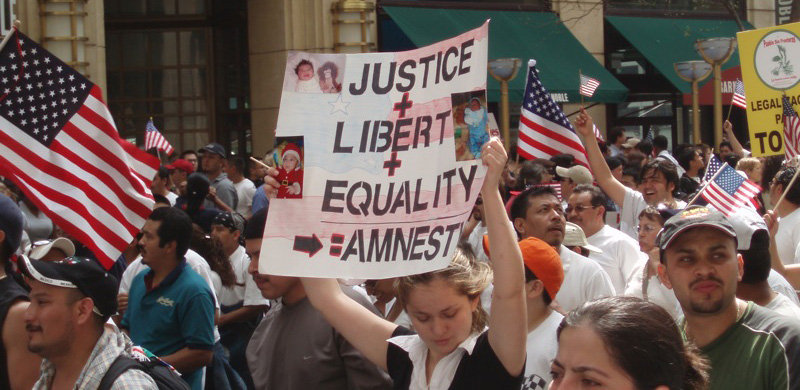Amnesty For All

Immigrants marched to demand amnesty for the undocumented on May Day 2007 in Chicago. Photo: Time Out Chicago, CC-BY-2.0, cropped from original.
In April the U.S. government carried out its largest workplace raid on immigrants in 10 years, detaining 280 people in Texas.
It’s the latest attack by a president who campaigned on the threat to build a wall along the Mexican border and has repeatedly tried to ban all migrants from several majority-Muslim countries.
The excuse for all this is an alleged crisis of immigration.
So what is this crisis? In the year 2000, 1.7 million people were apprehended at the border entering the U.S. without papers. In 2018 there were only 400,000, primarily driven by unsafe conditions in Guatemala, El Salvador, and Honduras.
The total undocumented population in the U.S., at 11 million, is down slightly from past years.
THE REAL CRISIS
This fake crisis, though, has been used by those who want to re-elect President Trump to generate a real crisis.
We get millions of detentions and deportations, under Democrats and Republicans alike, disrupting and destroying the lives of working people. On any given day last year, an average of 42,000 immigrants were held in jails and detention centers.
Asylum seekers who fear for their lives are denied entry. Children are ripped from their families and jailed at the border or sent to adoptive homes.
And for the 11 million who live here without papers, the constant threat looming over their heads makes it near impossible to stand up for their rights.
LOOKING FOR ANSWERS

SUPPORT LABOR NOTES
BECOME A MONTHLY DONOR
Give $10 a month or more and get our "Fight the Boss, Build the Union" T-shirt.
For decades the AFL-CIO has commendably taken the side of immigrants, advocating to legalize Dreamers—undocumented young people who were brought into the country at a young age—and prolong the Temporary Protected Status that allows people from devastated countries to stay in the United States.
But these are partial fixes that would cover only part of the undocumented population, and they come with strings attached. The AFL-CIO’s Executive Council recognized as much way back in 2000, when it called for an unconditional amnesty.
Labor has since followed mainstream immigration groups, church groups, and politicians to advocate “comprehensive immigration reform.” The idea, promoted by Democrats and some Republicans, is that Congress should address border security and legalization together.
Even in its best iterations, this approach weds partial amnesty for several million people to increased violence against migrants at the border, English tests, fines, and other punitive steps.
And all these bipartisan proposals imply that the U.S. will still maintain a low-wage workforce whose status is more restricted than that of citizen workers. Even for those who are allowed to become citizens, the process would take years. Guest worker programs are likely to be expanded.
What’s needed is a solution that will shift the whole debate, the way proposals for a Green New Deal and Medicare for All have changed our ideas of what's possible on climate change and health care.
Amnesty would wipe out one way employers keep wages down. It would treat undocumented workers fairly. Ending the punitive regime of jailings and deportations would strengthen communities because those now undocumented would be free to fully access public services like schools and city agencies.
AMNESTY NOW
Winning such an amnesty would require powerful organizing by immigrants and their allies. This happened in 2006, when millions joined mass marches in L.A. and Chicago. But proponents of “comprehensive immigration reform” quickly seized on the protests and co-opted them.
So far the AFL-CIO has backed an incomplete solution. Can it be pressured to ask, again, for something better?






